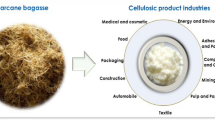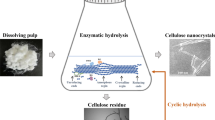Abstract
The reuse of the solid residues generated in the production of second-generation (2G) ethanol to obtain high-value products is a potential strategy for improving the economic and environmental viability of the overall process. This study evaluated the feasibility of using the residual solids remaining after the enzymatic hydrolysis of sugarcane bagasse for the production of cellulose nanocrystals (CNC), a valuable bionanomaterial. To this end, sugarcane bagasse subjected to steam explosion (SEB) or liquid hot water (LHWB) pretreatment was hydrolysed using different loadings of a commercial cellulase cocktail. Samples of SEB and LHWB were hydrolysed enzymatically, resulting in glucose releases close to 40 g/L, which would be suitable for producing 2G ethanol by microbial fermentation. The solid residues after the enzymatic hydrolysis step presented cellulose contents of up to 54 %, indicating that a significant amount of recalcitrant crystalline cellulose remained available for subsequent use. These solid residues were purified and submitted to acid hydrolysis, resulting in the successful formation of CNC with crystallinity close to 80 %, lengths of 193–246 nm and diameters of 14–18 nm. The CNC produced presented morphology, dimensions, physical-chemical characteristics, thermal stability and crystallinity within the ranges reported for this type of material. Moreover, the enzyme loading or the type of hydrothermal pretreatment process employed here showed no significant effects on the CNC obtained, indicating that these variables could be flexibly adjusted according to specific interests.









Similar content being viewed by others
References
Pereira SC, Maehara L, Machado CMM, Farinas CS (2015) 2G ethanol from the whole sugarcane lignocellulosic biomass. Biotechnol Biofuels 8:16
Khare SK, Pandey A, Larroche C (2015) Current perspectives in enzymatic saccharification of lignocellulosic biomass. Biochem Eng J 102:38–44
CONAB (2014) CONAB (Companhia Nacional de Abastecimento): Acompanhamento da safra brasileira de cana-de-açúcar
RFA (2014) RFA (renewable fuels association): world fuel ethanol production. ed.)^eds)
Granbio (2016) http://www.granbio.com.br/en/
Corporation I (2016) http://www.iogen.ca/raizen-project/index.html
Sun J, Sun X, Zhao H, Sun R (2004) Isolation and characterization of cellulose from sugarcane bagasse. Polym Degrad Stab 84:331–339
Oksman K, Etang JA, Mathew AP, Jonoobi M (2011) Cellulose nanowhiskers separated from a bio-residue from wood bioethanol production. Biomass Bioenerg 35:146–152
Zhu JY, Sabo R, Luo XL (2011) Integrated production of nano-fibrillated cellulose and cellulosic biofuel (ethanol) by enzymatic fractionation of wood fibers. Green Chem 13:1339–1344
Osullivan AC (1997) Cellulose: the structure slowly unravels. Cellulose 4:173–207
Correa AC, Teixeira ED, Pessan LA, Mattoso LHC (2010) Cellulose nanofibers from curaua fibers. Cellulose 17:1183–1192
Paakko M, Vapaavuori J, Silvennoinen R, Kosonen H, Ankerfors M, Lindstrom T, Berglund LA, Ikkala O (2008) Long and entangled native cellulose I nanofibers allow flexible aerogels and hierarchically porous templates for functionalities. Soft Matter 4:2492–2499
Li F, Mascheroni E, Piergiovanni L (2015) The potential of NanoCellulose in the packaging field: a review. Packag Technol Sci 28:475–508
Brinchi L, Cotana F, Fortunati E, Kenny JM (2013) Production of nanocrystalline cellulose from lignocellulosic biomass: technology and applications. Carbohydr Polym 94:154–169
Pasquini D, Teixeira EM, Curvelo AAS, Belgacem MN, Dufresnea A (2010) Extraction of cellulose whiskers from cassava bagasse and their applications as reinforcing agent in natural rubber. Ind Crop Prod 32:486–490
Arrieta MP, Fortunati E, Dominici F, Lopez J, Kenny JM (2015) Bionanocomposite films based on plasticized PLA-PHB/cellulose nanocrystal blends. Carbohydr Polym 121:265–275
Li XJ, Qiu C, Ji N, Sun CX, Xiong L, Sun QJ (2015) Mechanical, barrier and morphological properties of starch nanocrystals-reinforced pea starch films. Carbohydr Polym 121:155–162
Lin N, Dufresne A (2014) Nanocellulose in biomedicine: current status and future prospect. Eur Polym J 59:302–325
Celluforce (2016) http://celluforce.com/en/index.php
Inc. AP (2016) http://americanprocess.com/Default.aspx
Haafiz MKM, Hassan A, Zakaria Z, Inuwa IM (2014) Isolation and characterization of cellulose nanowhiskers from oil palm biomass microcrystalline cellulose. Carbohydr Polym 103:119–125
Chen Y, Liu CH, Chang PR, Cao XD, Anderson DP (2009) Bionanocomposites based on pea starch and cellulose nanowhiskers hydrolyzed from pea hull fibre: effect of hydrolysis time. Carbohydr Polym 76:607–615
Teixeira ED, Correa AC, Manzoli A, Leite FL, de Oliveira CR, Mattoso LHC (2010) Cellulose nanofibers from white and naturally colored cotton fibers. Cellulose 17:595–606
Teixeira ED, Bondancia TJ, Teodoro KBR, Correa AC, Marconcini JM, Mattoso LHC (2011) Sugarcane bagasse whiskers: extraction and characterizations. Ind Crop Prod 33:63–66
Li JH, Wei XY, Wang QH, Chen JC, Chang G, Kong LX, Su JB, Liu YH (2012) Homogeneous isolation of nanocellulose from sugarcane bagasse by high pressure homogenization. Carbohydr Polym 90:1609–1613
Moran JI, Alvarez VA, Cyras VP, Vazquez A (2008) Extraction of cellulose and preparation of nanocellulose from sisal fibers. Cellulose 15:149–159
Martins DF, de Souza AB, Henrique MA, Silverio HA, Neto WPF, Pasquini D (2015) The influence of the cellulose hydrolysis process on the structure of cellulose nanocrystals extracted from capim mombaca (Panicum maximum). Ind Crop Prod 65:496–505
Rosa MF, Medeiros ES, Malmonge JA, Gregorski KS, Wood DF, Mattoso LHC, Glenn G, Orts WJ, Imam SH (2010) Cellulose nanowhiskers from coconut husk fibers: effect of preparation conditions on their thermal and morphological behavior. Carbohydr Polym 81:83–92
Danial WH, Majid ZA, Muhid MNM, Triwahyono S, Bakar MB, Ramli Z (2015) The reuse of wastepaper for the extraction of cellulose nanocrystals. Carbohydr Polym 118:165–169
Tsukamoto J, Duran N, Tasic L (2013) Nanocellulose and bioethanol production from orange waste using isolated microorganisms. J Braz Chem Soc 24:1537–1543
Leistritz FL, Senechal DM, Stowers MD, McDonald WF, Saffron CM and Hodur NM (2006) Preliminary feasibility analysis for an integrated biomaterials and ethanol biorefinery using wheat straw feedstock. In Agribusiness & Applied Economics Report No. 590
Gouveia E, do Nascimento R, Souto-Maior A, Rocha G (2009) Validation of methodology for the chemical characterization of sugar cane bagasse. Quim Nov. 32:1500–1503
Segal L, Creely JJ, Martin AE, Conrad CM (1959) An empirical method for estimating the degree of crystallinity of native cellulose using the X-ray diffractometer. Text Res J 29:786–794
Bradford MM (1976) A rapid and sensitive method for the quantitation of microgram quantities of protein utilizing the principle of protein-dye binding. Anal Biochem 72:248–254
Alvira P, Tomas-Pejo E, Ballesteros M, Negro MJ (2010) Pretreatment technologies for an efficient bioethanol production process based on enzymatic hydrolysis: a review. Bioresour Technol 101:4851–4861
Aguiar RS, Luciano Silveira MH, Pitarelo AP, Corazza ML, Ramos LP (2013) Kinetics of enzyme-catalyzed hydrolysis of steam-exploded sugarcane bagasse. Bioresour Technol 147:416–423
Pu YQ, Hu F, Huang F, Davison BH, Ragauskas AJ (2013) Assessing the molecular structure basis for biomass recalcitrance during dilute acid and hydrothermal pretreatments. Biotechnol Biofuels 6:13
Ko JK, Ximenes E, Kim Y, Ladisch MR (2015) Adsorption of enzyme onto lignins of liquid hot water pretreated hardwoods. Biotechnol Bioeng 112:447–456
Kim Y, Kreke T, Ko JK, Ladisch MR (2015) Hydrolysis-determining substrate characteristics in liquid hot water pretreated hardwood. Biotechnol Bioeng 112:677–687
Nakagame S, Chandra RP, Saddler JN (2010) The effect of isolated lignins, obtained from a range of pretreated lignocellulosic substrates, on enzymatic hydrolysis. Biotechnol Bioeng 105:871–879
Haven MO, Jorgensen H (2013) Adsorption of beta-glucosidases in two commercial preparations onto pretreated biomass and lignin. Biotechnol Biofuels 6:14
Lu Q-l, Tang L-r, Wang S, Huang B, Chen Y-d, Chen X-r (2014) An investigation on the characteristics of cellulose nanocrystals from Pennisetum sinese. Biomass Bioenergy 70:267–272
Roman M, Winter WT (2004) Effect of sulfate groups from sulfuric acid hydrolysis on the thermal degradation behavior of bacterial cellulose. Biomacromolecules 5:1671–1677
Boujemaoui A, Mongkhontreerat S, Malmstrom E, Carlmark A (2015) Preparation and characterization of functionalized cellulose nanocrystals. Carbohydr Polym 115:457–464
Alemdar A, Sain M (2008) The influence of the cellulose hydrolysis process on the structure of cellulose nanocrystals extracted from capim mombac¸ a (Panicummaximum). Bioresour Technol 99:1664–1671
Ng H-M, Sin LT, Tee T-T, Bee S-T, Hui D, Low C-Y, Rahmat AR (2015) Extraction of cellulose nanocrystals from plant sources for application as reinforcing agent in polymers. Compos Part B 75:176–200
Teixeira E d M, Pasquini D, Curvelo AAS, Corradini E, Belgacem MN, Dufresne A (2009) Cassava bagasse cellulose nanofibrils reinforced thermoplastic cassava starch. Carbohydr Polym 78:422–431
Acknowledgments
The authors would like to thank the Brazilian research funding agencies CAPES, CNPq, FAPESP, SISNANO/MCTI, Agronano Network and the Brazilian Agricultural Research Corporation (Embrapa).
Author information
Authors and Affiliations
Corresponding author
Rights and permissions
About this article
Cite this article
Camargo, L.A., Pereira, S.C., Correa, A.C. et al. Feasibility of Manufacturing Cellulose Nanocrystals from the Solid Residues of Second-Generation Ethanol Production from Sugarcane Bagasse. Bioenerg. Res. 9, 894–906 (2016). https://doi.org/10.1007/s12155-016-9744-0
Published:
Issue Date:
DOI: https://doi.org/10.1007/s12155-016-9744-0




